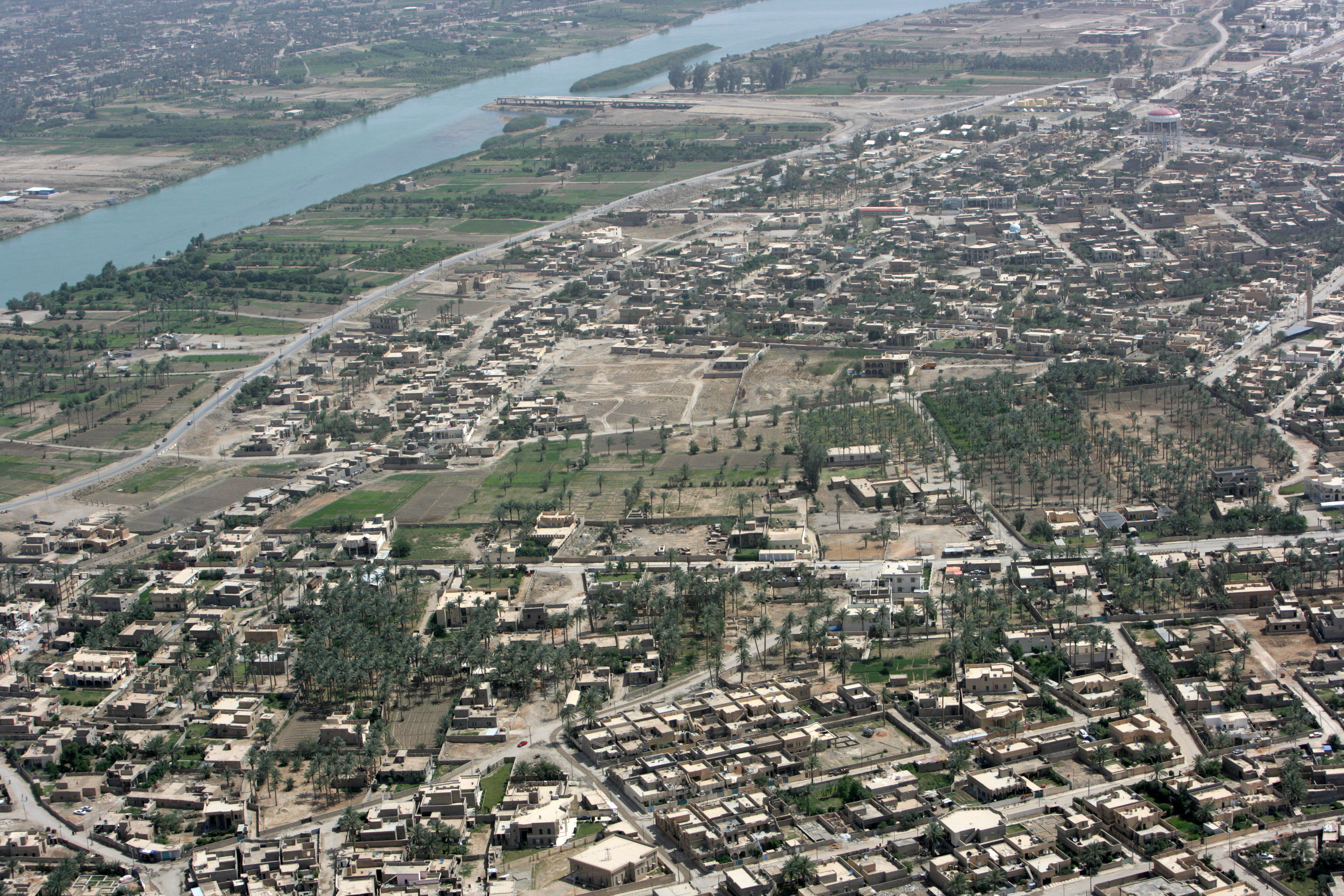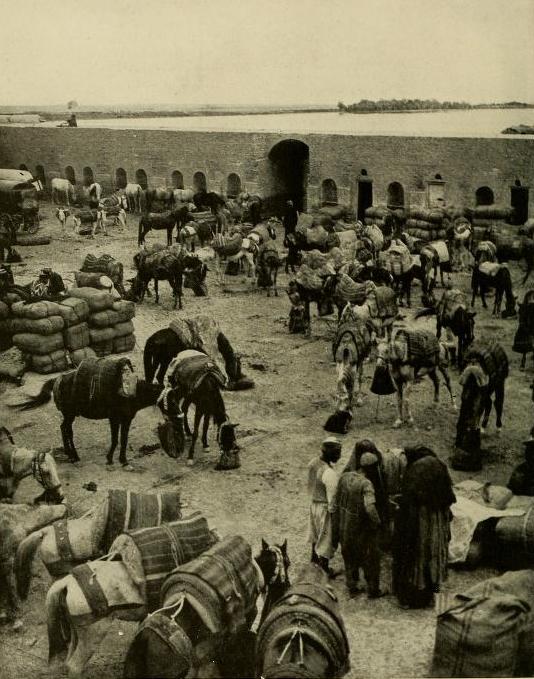|
Fallujah Barrage
The Fallujah Barrage is a barrage on the Euphrates near Fallujah in Al Anbar Governorate, Iraq. Construction of the barrage was completed in 1985. Unlike many other dams in the Euphrates, the Fallujah Barrage does not include a hydroelectric power station and its main function is to raise the water level of the river for irrigation. The barrage consists of two separate parts. The main stretch of the barrage has ten gates measuring , allowing a maximum discharge of per second. The second part on the left bank of the river has eight gates that are wide. These gates divert water toward two separate irrigation channels. Their maximum discharge is per second. The construction of the Fallujah Barrage was first proposed in 1923 as part of a large project to increase the production of cotton Cotton (), first recorded in ancient India, is a soft, fluffy staple fiber that grows in a boll, or protective case, around the seeds of the cotton plants of the genus '' Gossypium'' in th ... [...More Info...] [...Related Items...] OR: [Wikipedia] [Google] [Baidu] |
Euphrates
The Euphrates ( ; see #Etymology, below) is the longest and one of the most historically important rivers of West Asia. Tigris–Euphrates river system, Together with the Tigris, it is one of the two defining rivers of Mesopotamia (). Originating in Turkey, the Euphrates flows through Syria and Iraq to join the Tigris in the Shatt al-Arab in Iraq, which empties into the Persian Gulf. The Euphrates is the List of longest rivers of Asia, fifteenth-longest river in Asia and the longest in West Asia, at about , with a drainage area of that covers six countries. Etymology The term ''Euphrates'' derives from the Koine Greek, Greek ''Euphrátēs'' (), adapted from , itself from . The Elamite name is ultimately derived from cuneiform 𒌓𒄒𒉣; read as ''Buranun'' in Sumerian language, Sumerian and ''Purattu'' in Akkadian language, Akkadian; many cuneiform signs have a Sumerian pronunciation and an Akkadian pronunciation, taken from a Sumerian word and an Akkadian word that mean ... [...More Info...] [...Related Items...] OR: [Wikipedia] [Google] [Baidu] |
Al Anbar Governorate
Al Anbar Governorate (; ''muḥāfaẓat al-’Anbār''), or Anbar Province, is the largest governorate in Iraq by area. Encompassing much of the country's western territory, it shares borders with Syria, Jordan, and Saudi Arabia. The population is mostly Sunni Arabs. The provincial capital is Ramadi; other important cities include Fallujah, Al-Qa'im and Haditha. The governorate was known as Ramadi up to 1976 when it was renamed Al Anbar Province, and it was known as ''Dulaim'' before 1962. A large majority of the inhabitants of the province are Arab Sunni Muslims and most belong to the Dulaim tribe. In early 2014, the Islamic State, with the assistance of some local Sunni militias, launched a successful campaign to seize control of the province from the Iraqi government. Numerous offensive actions were undertaken by the Iraqi government, with the assistance of local Sunni tribes to remove IS's occupation of the province, especially in the Anbar campaign (2015–16), the W ... [...More Info...] [...Related Items...] OR: [Wikipedia] [Google] [Baidu] |
Iraq
Iraq, officially the Republic of Iraq, is a country in West Asia. It is bordered by Saudi Arabia to Iraq–Saudi Arabia border, the south, Turkey to Iraq–Turkey border, the north, Iran to Iran–Iraq border, the east, the Persian Gulf and Kuwait to the Iraq–Kuwait border, southeast, Jordan to Iraq–Jordan border, the southwest, and Syria to Iraq–Syria border, the west. The country covers an area of and has Demographics of Iraq, a population of over 46 million, making it the List of countries by area, 58th largest country by area and the List of countries by population, 31st most populous in the world. Baghdad, home to over 8 million people, is the capital city and the List of largest cities of Iraq, largest in the country. Starting in the 6th millennium BC, the fertile plains between Iraq's Tigris and Euphrates rivers, referred to as Mesopotamia, fostered the rise of early cities, civilisations, and empires including Sumer, Akkadian Empire, Akkad, and Assyria. Known ... [...More Info...] [...Related Items...] OR: [Wikipedia] [Google] [Baidu] |
Barrage (dam)
A barrage is a type of Head (hydraulic), low-head, diversion dam which consists of a number of large gates that can be opened or closed to control the amount of water passing through. This allows the structure to regulate and stabilize river water elevation upstream for use in irrigation and other systems. The gates are set between flanking piers which are responsible for supporting the water load of the pool created. The term '':wikt:barrage, barrage'' is borrowed from the French Language, French word "barrer" meaning "to bar". Dam construction Barrage dams have a series of gates that control the amount of water passing through. A barrage dam can be used to divert water for irrigation needs or limit the amount of water downstream. In most cases, a barrage dam is built near the mouth of the river. The site of dam construction needs to be thoroughly investigated to ensure that the foundation is strong enough to support the dam and has low possibility of failing. When dams a ... [...More Info...] [...Related Items...] OR: [Wikipedia] [Google] [Baidu] |
Fallujah
Fallujah ( ) is a city in Al Anbar Governorate, Iraq. Situated on the Euphrates, Euphrates River, it is located roughly to the west of the capital city of Baghdad and from the neighboring city of Ramadi. The city is located in the region defined as Sunni Triangle by the United States, as the majority of its residents are Sunni Islam in Iraq, Sunni Arabs. In 1947, Fallujah was a small town with a relatively small population but had grown to a population of about 250,900 people by 2018. Following the 2003 invasion of Iraq, which triggered the Iraq War, the city became a major centre of resistance during Iraqi insurgency (2003–2011), insurgency. The United States, the United Kingdom, and the Iraqi Interim Government twice engaged in fierce urban combat with insurgents throughout the city; the First Battle of Fallujah, first battle of Fallujah failed to dislodge the insurgents, triggering the Second Battle of Fallujah, second battle, in which the coalition forces successful ... [...More Info...] [...Related Items...] OR: [Wikipedia] [Google] [Baidu] |
Hydroelectricity
Hydroelectricity, or hydroelectric power, is Electricity generation, electricity generated from hydropower (water power). Hydropower supplies 15% of the world's electricity, almost 4,210 TWh in 2023, which is more than all other Renewable energy, renewable sources combined and also more than nuclear power. Hydropower can provide large amounts of Low-carbon power, low-carbon electricity on demand, making it a key element for creating secure and clean electricity supply systems. A hydroelectric power station that has a dam and reservoir is a flexible source, since the amount of electricity produced can be increased or decreased in seconds or minutes in response to varying electricity demand. Once a hydroelectric complex is constructed, it produces no direct waste, and almost always emits considerably less greenhouse gas than fossil fuel-powered energy plants. [...More Info...] [...Related Items...] OR: [Wikipedia] [Google] [Baidu] |
Irrigation
Irrigation (also referred to as watering of plants) is the practice of applying controlled amounts of water to land to help grow crops, landscape plants, and lawns. Irrigation has been a key aspect of agriculture for over 5,000 years and has been developed by many cultures around the world. Irrigation helps to grow crops, maintain landscapes, and revegetation, revegetate disturbed soils in dry areas and during times of below-average rainfall. In addition to these uses, irrigation is also employed to protect crops from frost, suppress weed growth in grain fields, and prevent soil consolidation. It is also used to cool livestock, reduce dust, dispose of sewage, and support mining operations. Drainage, which involves the removal of surface and sub-surface water from a given location, is often studied in conjunction with irrigation. There are several methods of irrigation that differ in how water is supplied to plants. Surface irrigation, also known as gravity irrigation, is the olde ... [...More Info...] [...Related Items...] OR: [Wikipedia] [Google] [Baidu] |
Cotton
Cotton (), first recorded in ancient India, is a soft, fluffy staple fiber that grows in a boll, or protective case, around the seeds of the cotton plants of the genus '' Gossypium'' in the mallow family Malvaceae. The fiber is almost pure cellulose, and can contain minor percentages of waxes, fats, pectins, and water. Under natural conditions, the cotton bolls will increase the dispersal of the seeds. The plant is a shrub native to tropical and subtropical regions around the world, including the Americas, Africa, Egypt and India. The greatest diversity of wild cotton species is found in Mexico, followed by Australia and Africa. Cotton was independently domesticated in the Old and New Worlds. The fiber is most often spun into yarn or thread and used to make a soft, breathable, and durable textile. The use of cotton for fabric is known to date to prehistoric times; fragments of cotton fabric dated to the fifth millennium BC have been found in the Indus Valley civilizat ... [...More Info...] [...Related Items...] OR: [Wikipedia] [Google] [Baidu] |
Anbar Clashes (2013–14)
Anbar may refer to: Places and jurisdictions Iraq * Anbar (town), near Iraqi capital Baghdad * Al Anbar Governorate Al Anbar Governorate (; ''muḥāfaẓat al-’Anbār''), or Anbar Province, is the largest governorate in Iraq by area. Encompassing much of the country's western territory, it shares borders with Syria, Jordan, and Saudi Arabia. The population ..., a province of Iraq Elsewhere * Anbar, Iran (other) * Anbar, Swabi, Pakistan * Anbar, Kocaköy Other uses * Electricity, in ''His Dark Materials'', by Philip Pullman; see ''His Dark Materials'' terminology See also * Anbari (other) * Anwar (other) {{dab, geodis ... [...More Info...] [...Related Items...] OR: [Wikipedia] [Google] [Baidu] |
Dams In Iraq
The following is a list of dams and reservoirs in Iraq. They are sorted according to their location in either the Euphrates or the Tigris river basin. Dams in the Euphrates basin *Duban Regulator, on the Euphrates, regulating the flow of the Euphrates into Lake Habbaniyah *Fallujah Barrage, on the Euphrates * Haditha Dam, on the Euphrates, creating Lake Qadisiyah * Hindiya Barrage, on the Hindiya branch of the Euphrates * Ramadi Barrage, on the Euphrates *Warrar Regulator, on the Euphrates *Three dams in Wadi Hauran (Hussayniyah dam, Rutba dam, and the Hauran dam) Dams in the Tigris basin *Adhaim Dam, on the Adhaim River * Alwand Dam, on the Alwand River * Badush Dam (incomplete), on the Tigris * Bastora Dam (under construction), on the Bastora River * Bawanur Dam (under construction), on the Diyala River * Beduhe Dam, on the Beduhe River * Bekhme Dam (incomplete), on the Great Zab * Darbandikhan Dam, on the Diyala River * Deralok Dam (under construction), on the Great Zab * ... [...More Info...] [...Related Items...] OR: [Wikipedia] [Google] [Baidu] |
Dams Completed In 1985
A dam is a barrier that stops or restricts the flow of surface water or underground streams. Reservoirs created by dams not only suppress floods but also provide water for activities such as irrigation, human consumption, industrial use, aquaculture, and navigability. Hydropower is often used in conjunction with dams to generate electricity. A dam can also be used to collect or store water which can be evenly distributed between locations. Dams generally serve the primary purpose of retaining water, while other structures such as floodgates or levees (also known as dikes) are used to manage or prevent water flow into specific land regions. The word ''dam'' can be traced back to Middle English, and before that, from Middle Dutch, as seen in the names of many old cities, such as Amsterdam and Rotterdam. Ancient dams were built in Mesopotamia and the Middle East for water control. The earliest known dam is the Jawa Dam in Jordan, dating to 3,000 BC. Egyptians also built dams, ... [...More Info...] [...Related Items...] OR: [Wikipedia] [Google] [Baidu] |





